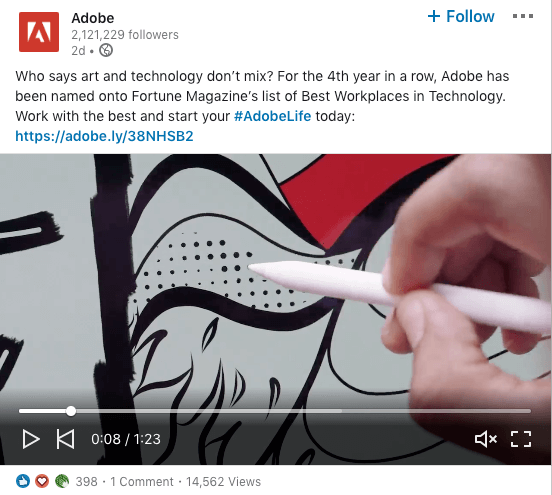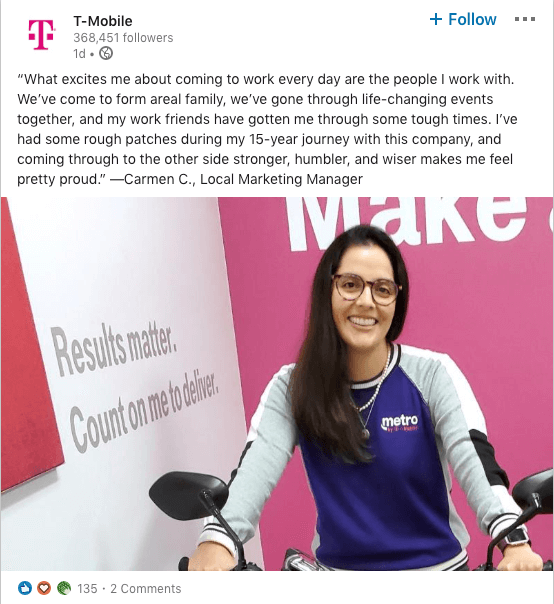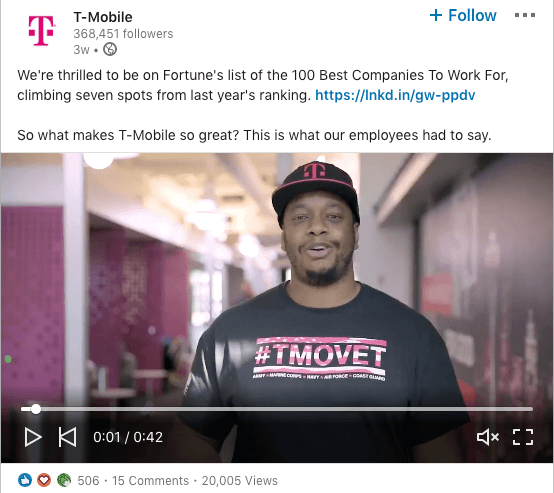There is no doubt that the way organizations recruit and attract top talent has changed. People are looking for better cultures and more work flexibility.
And potential employees are also paying attention to recommendations from colleagues and also online content about your organization. This means social media recruiting has become a key strategy for businesses to attract and hire job candidates.
But it also organically starts building the job pool, even when there might not be any open positions currently. This is a great problem to have!
Below you’ll learn more about social media recruiting strategy, tools to help you and your company succeed, and social media recruiting examples.
- How is Social Media Used for Recruiting?
- Social Media Recruiting Statistics
- Social Media Recruiting Strategy
- Some Social Media Recruiting Tools
- Best Social Media Recruiting Examples
How is Social Media Used for Recruiting?
By now, it’s a safe bet your company and many others are already highly focused on social media recruiting.
After all, the main social platforms (LinkedIn, Twitter, and Facebook) have dominated this last decade and shifted to be more important for business than ever before.
But social media is used for recruiting by helping you find and easily connect with the right candidate. Yet, it also helps your brand and company culture reach more audiences and organically attract talent.
Your company can use social media platforms by posting via branded profiles, recruiters and other employees sharing to their networks.
Paid social advertising can be used to reach target candidates, additionally unique campaigns are effective for recruiting.
Social Media Recruiting Statistics
So just how important is social recruiting to hiring and attracting talent?
There are millions of people on any given major social platform following your company and connected to your people.
And over the last few years there has been a ton of research and data shared related to recruiting.
Here are some social media recruiting statistics that should catch your eyes. If you are looking for a more in-depth list, we got you covered here.
- 79% of job applicants use social media in their job search, according to Glassdoor.
- A study from the Aberdeen Group revealed that millennials are changing social recruitment practices: 73 percent of millennials (18-34 age group) found their last position through a social media platform. (CareerProfiles)
- 70% of hiring managers say they’ve successfully hired with social media. (Betterteam)
- Job seekers rank social media and professional networks as the most useful job search resource compared to job boards, job ads, recruiting agencies, and recruiting events. (CareerArc)
- 75% of U.S. respondents believe that companies whose C-Suite executives and leadership team use social media to communicate about their core mission, brand values and purpose are more trustworthy. (Glassdoor)
Social Media Recruiting Strategy
In order to build your social media recruiting machine, you need to formulate a social media recruiting strategy that will ensure results.
Randomly posting new job openings is not a strategy, nor is this a formal plan that will help you build a recruiting pipeline.
Below are some standard practices to follow, which will help your organization succeed with its social media recruiting strategy.
There are plenty of additional tactics and unique campaigns you might want to run, but the below best practices should be where you start.
Social Content Should Reflect Your Brand
Your workplace culture is a big indicator to potential hires of what they can expect when working for your company.
Additionally, the company brand identity needs to be consistent with the social posts that are used for recruiting and employer brand too.
You ideally want everything to tie together consistently and not be disconnected.
Establish Your Reputation
When your company has a strong reputation and is seen as an authoritative source, you’ll find your social posts will generate more engagement and interest in your brand.
People trust the expertise and start to see the company as a great place to work.
The more of an emotional connection that you invite people to have with your brand, the more interest there will be in working at your company.
Use the Right Social Platforms
You’ll also want to do some research in your ideal job candidates and departments. As well as where in your industry the talent you want to attract hangs out and engages with opportunities.
Choose the social platforms that make the most sense and learn how your brand can engage with your target candidate pool.
And as you most likely engage on multiple platforms, be careful to not post the exact same content and messages at the same time.
Pay attention to how people engage, what content seems to stand out, and where certain career-types are most likely to see your content.
Mix Up the Content Types
Certainly sharing application links to open positions is a great asset to include in your social media recruiting machine.
But that formula can get stale (especially on social media) and doesn’t really excite your target candidates.
That means you need more unique content to intrigue and generate hype when jobs are available. Use videos, pictures, gifs, live streaming, and blog posts about culture, executives, company milestones, career growth, and employees.
Some of the best content for recruiting are employee stories — showcasing diversity, interests, and what real people are saying about the organization.
But it can also be tours of the offices, company events or volunteer work, transparency of the workplace, and much more.
Activate Employees to Help
In a survey from Monster, 65% of respondents would consider a new job opportunity if they heard about it through a personal connection in their network.
Not only do your recruiting and talent acquisition teams have untapped social networks, but so do employees of all different departments.
Many of these networks may not be familiar with your brand or looking for new job opportunities.
Something as simple as sharing job postings all the way to creating and sharing unique workplace culture content can have a huge impact on your social media recruiting pipeline.
And according to Jobvite, 47% of referral hires have greater job satisfaction and stay longer at companies.
That’s huge in driving retention and saving on recurring hiring costs. Many organizations are having amazing results by doing just this.
Now you’ll want to ensure you have a social media policy in place and an employee advocacy platform (more on that in the next section).
Continue to Engage Consistently
Sometimes the mistakes a brand makes with social recruiting is only sharing or creating content when something is available.
Additionally, do not ignore any engagement on recruiting social posts. If there are questions related to the job or work environment, be sure to engage back. It just shows how active your brand is with engaging the audience.
But, in order to build that reputation and keep the recruiting pipeline healthy and growing, your company’s social media recruiting strategy must also mix in recruiting and employer branding content.
Keep this stuff as a top priority and on a consistent schedule, even if you aren’t exactly hiring at the moment.
Start Using the Social Search Features
All the major social media platforms have decent search functionalities by which you can dig deep into the profiles who are engaging and any targets you want to attract.
Typically LinkedIn would be the go-to for this, since it is a professional and career orientated social network.
But Facebook and Twitter also provide ways for you to find people. They might not be as robust, but you can really start to find, follow, and see interests which can all help guide your own social media recruiting content and tactics.
Monitor Social Recruiting Results
And of course, you must also track your social media results with your recruiting materials.
Many of this can be accomplished with social networks analytics, a reporting platform like Google Analytics, and if you are using an employee advocacy platform, there will be robust reporting functionality as well.
Some metrics to monitor pending your social media recruiting strategy:
- How many engagements social recruiting posts are getting (likes and comments)
- How many video videos or clicks links receive
- The social media traffic generating to job or career pages
- Any social recruiting conversions to open job positions
- Look at the results from employees engaging and sharing content
- Paid social results (if doing any for recruiting). Conversions, cost-per-click, spend, etc.
Social Media Recruiting Tools
There are plenty of software packages and tools out there for companies to address all sorts of social media needs.
And while marketing and sales generally have the biggest tech stack choices, there are plenty of social media recruiting tools as well.
While I won’t get into every category of solution options, here are some top choices when it comes to social recruiting and employer branding needs. These can be crucial to the success and long-term results of your recruiting strategy.
Note: Not all are directly related to social media recruiting, but can be used to help your strategy succeed.
Buffer
In order to get organized and share to branded social media accounts, Buffer can be a great option.
With this platform, you can do everything from publishing scheduled content, engaging with a target audience and analyzing the performance through any social efforts.
And there are custom access levels, so if your marketing team has more control, they can still grant social recruiting teams access to use it as well.
LinkedIn Talent Solutions
While you will probably be sharing recruiting material on multiple social channels, LinkedIn offers additional assistance in recruiting.
You’ll get the ability to create a career page, be able to reach your target candidates via ads, manage your pipeline, and also communicate via direct messages.
LinkedIn has a massive reach of over 500 million people and people are open to engaging and finding new jobs. So it makes sense to consider this option for your social media recruiting.
EveryoneSocial
Our own employee advocacy platform expands your recruiting efforts by helping to engage and retain your top talent.
Job seekers rank current employees as the most trusted source for information about a company. (CareerArc).
So why not harness those trusted voices and allow them to create and share recruiting content as it relates to your brand?
Besides that, recruiters can also use employee advocacy to organize recruiting and employer brand content, monitor analytics from shares, work closely with marketing on content needs, keep employees informed and engaged about the latest company hiring news, and still share to branded company pages as well.
There is plenty more to dive in, but head over to our recruiting solutions page to learn more.
SurveyMonkey
Although you might be surprised to see SurveyMonkey on this list for social recruiting tools, it’s actually a perfect complement.
The company has specific surveys that can help you gather feedback about work culture, your employees, and their careers that can be useful to your social recruiting efforts.
These surveys can be used to see how interested employees might be to take part in your social recruiting efforts as well. This keeps everything organized for your team and can help identify if there are any work culture gaps to improve on.
Best Social Media Recruiting Examples
Okay, so we dove into quite a bit here. And while this all sounds good and hopefully exciting, you may still need some inspiration.
After all, sometimes you need some good examples to get your own strategy rolling!
What is great about some of these examples is it’s not always about the jobs that are open. It’s about how they treat employees, what unique opportunities they have, the culture, and more.
Here are three social recruiting examples from brands that have mastered their strategy.
Adobe
If you have read some of our previous content, you know that we include Adobe often. While they are a customer of ours, they are also an amazing company. And yes, they also have built a strong social media recruiting presence.
Here is just an example from their LinkedIn company page. They use #AdobeLife when referencing their work culture, people who work there, and open positions.

Plus, they utilize EveryoneSocial for employee advocacy, thus elevating their social recruiting reach and employer brand via employee ambassadors.

UPS
What’s cool about social recruiting is that all industries and companies can succeed by using it.
Because social media recruiting is about creating a unique strategy that will attract the talent you want, any kind of company can benefit: especially those with frontline, retail, and deskless employees
UPS or “United Parcel Services” was founded over 100 years ago and still thrives today. The company adds variety to their social channels, but you’ll still find great content around recruiting and employer brand.
Take a look at this post that was shared on Facebook.

T-Mobile
As one the largest telecommunications platforms, T-Mobile is also a social media giant.
Between their active executives and employees sharing and the branded pages, the company has built an amazing recruiting pipeline via their social channels.

Take a look at any of their social channels, you’ll find plenty of content about their employees and work culture. And you can tell that their people really enjoy working for the company too, which encourages more talent to apply.

















